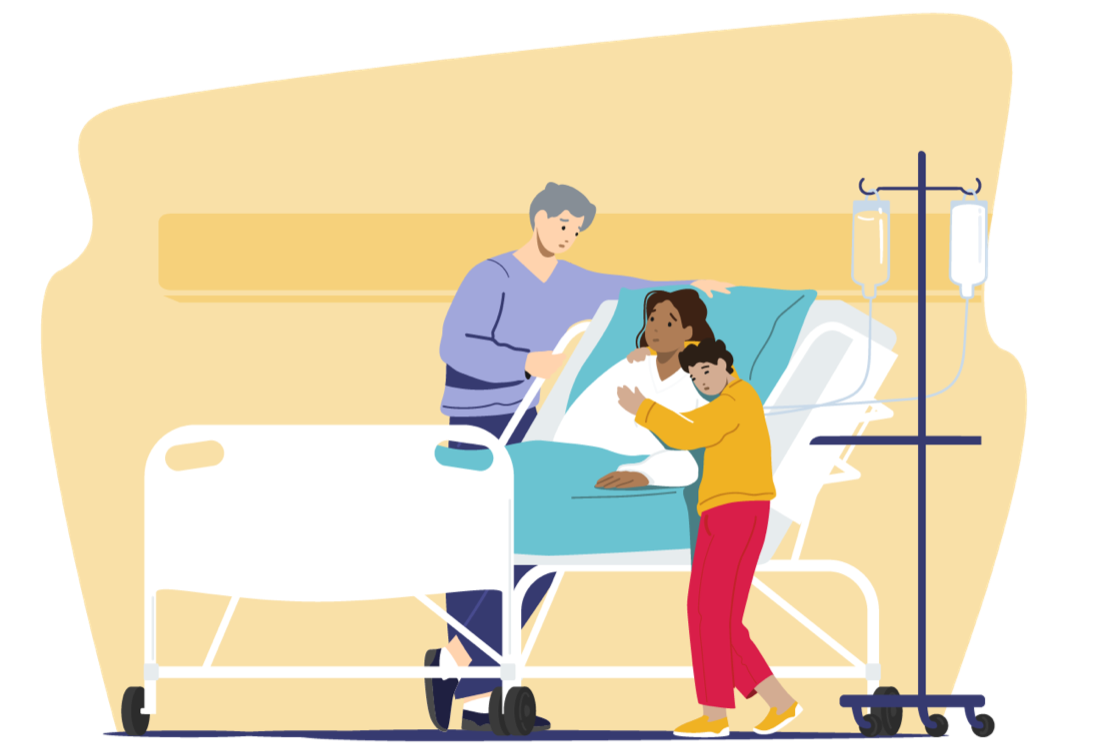In-hospital treatment
Understanding hospital treatment


Acute Myeloid Leukaemia (AML) can progress very quickly without treatment. Watch this video to understand why.1 Because of this, doctors might recommend staying in the hospital for several weeks when starting rounds of anticancer treatments. This in-hospital treatment allows for close monitoring of how the body responds to treatment.
If doctors recommend in-hospital treatment, this usually involves staying in the haematology ward in the hospital for chemotherapy. Everyone’s treatment journey is unique, but typically a hospital stay can take 4–6 weeks.2

Develop a routine in hospital
It’s important to develop some sort of routine as your hospital stay could be for several weeks. For example:
PLAN YOUR DAYS
Setting a daily plan with activities to pass the time can help provide some structure and routine to the day
GET CHANGED
Changing out of pyjamas can help break up the day, as you would outside of hospital
EAT AT A TABLE
Eat at a table, when possible, rather than in bed
GET MOVING
Gentle walking when energy levels are up, which will also help to manage muscle wastage
What happens after in-hospital treatment?
After the first round of chemotherapy, doctors will perform blood tests and a bone marrow test. These results will show how the body is responding to treatment and if it has started to slow the production of abnormal white blood cells.3
If you ever have any questions or concerns, reach out to your doctors and nurses for support.
Some patients may require additional treatments, such as another course of chemotherapy or a bone marrow transplant.3 Often, it is possible to go home for at least a week in between these treatments.3 Learn more about transplants here.
What is central venous access?
A central venous access (or a CVA) is a way of giving anticancer treatments straight into the bloodstream.4 This allows the treatment to work and destroy cancerous cells.
A CVA is a special type of catheter or ‘line’ that is inserted into a vein in the arm, neck or just below the collarbone. It allows medication to be given directly into the bloodstream.5 Doctors can also take blood samples through this. A CVA stays in place throughout treatment, to avoid doctors repeatedly using needles to give medication and take blood samples.6
If you ever have any questions or concerns, reach out to your doctors and nurses for support.
Why are some people with AML transferred to other parts of the hospital?
Unfortunately, some people being treated for AML may experience serious side effects or may not respond to treatment as hoped. In these cases, doctors often organise a transfer to a different part of the hospital. This would usually be to the intensive care unit (ICU) or the high dependency unit (HDU). These specialised units have more nurses, doctors and equipment to allow for extra monitoring.
Why do hospitals have specified visiting hours?
During treatment, the body is working hard against the acute leukaemia (or blood cancer), which can often lead to tiredness.7 Time dedicated to rest and recovery is crucial to help increase energy levels.7
To support this, it’s normal for doctors and nurses to limit visiting hours to certain times of the day. This varies in different hospitals and wards. It’s a good idea to check what a ward’s visiting hours are with the nursing staff.

What is a clinical trial?
Clinical trials are used to research potential new treatments and tests. They often have specific criteria for participation and may not be currently recruiting at the time of treatment. Doctors will be aware of suitable clinical trials enrolling people with AML within the region. Clinic visits are an excellent opportunity to discuss this further.
Relapse
Receiving a diagnosis of relapse can be overwhelming. However, some people find that increasing their medical knowledge can help with this.
Alisdair’s story
Watch this video to hear Alisdair’s thoughts on his time in hospital, and how he managed with a young family at home.

Informative brochure
Find more information about AML relapse in this helpful brochure from Leukaemia Care.
Jane’s story
Jane relapsed three months after achieving remission. Hear her story and what advice she would give others who have relapsed.
Find out more about
Managing AML - overview
What is the aim of the treatment? Is it the same for everyone? Find the answers to these questions and more
Treatment at home
How is treatment given? What is a 'day-ward'? Find the answers to these questions and more
Understanding bone marrow transplant
How are transplants given? Who is offered a transplant? Find the answers to these questions and more
References
1. Saultz JN and Garzon R. Acute Myeloid Leukemia: A Concise Review. J Clin Med 2016; 5 20160305.
2. Leukemia and Lymphoma Society (LLS). Chemotherapy. https://www.lls.org/leukemia/acute-lymphoblastic-leukemia/treatment/chemotherapy [Last accessed April 2022].
3. Blood Cancer UK. Acute Myeloid Leukemia Treatment phases. https://bloodcancer.org.uk/understanding-blood-cancer/leukaemia/acute-myeloid-leukaemia/aml-treatment-side-effects/aml-treatment-types-phases/ [Last accessed April 2022].
4. NHS. Chemotherapy, https://www.nhs.uk/conditions/chemotherapy/. [Last accessed April 2022]
5. Ge X, Cavallazzi R, Li C, et al. Central venous access sites for the prevention of venous thrombosis, stenosis and infection. Cochrane Database of Systematic Reviews 2012.
6. St. Georges Healthcare, NHS. Acute Central Venous Catheters. https://www.stgeorges.nhs.uk/wp-content/uploads/2014/07/Acute-venous-catheters.pdf [Last accessed April 2022].
7. Blood Cancer UK. Blood Cancer and Fatigue. https://bloodcancer.org.uk/support-for-you/living-well/fatigue/ [Last accessed April 2022].
HAE_2022_0017_IE | April 2022

